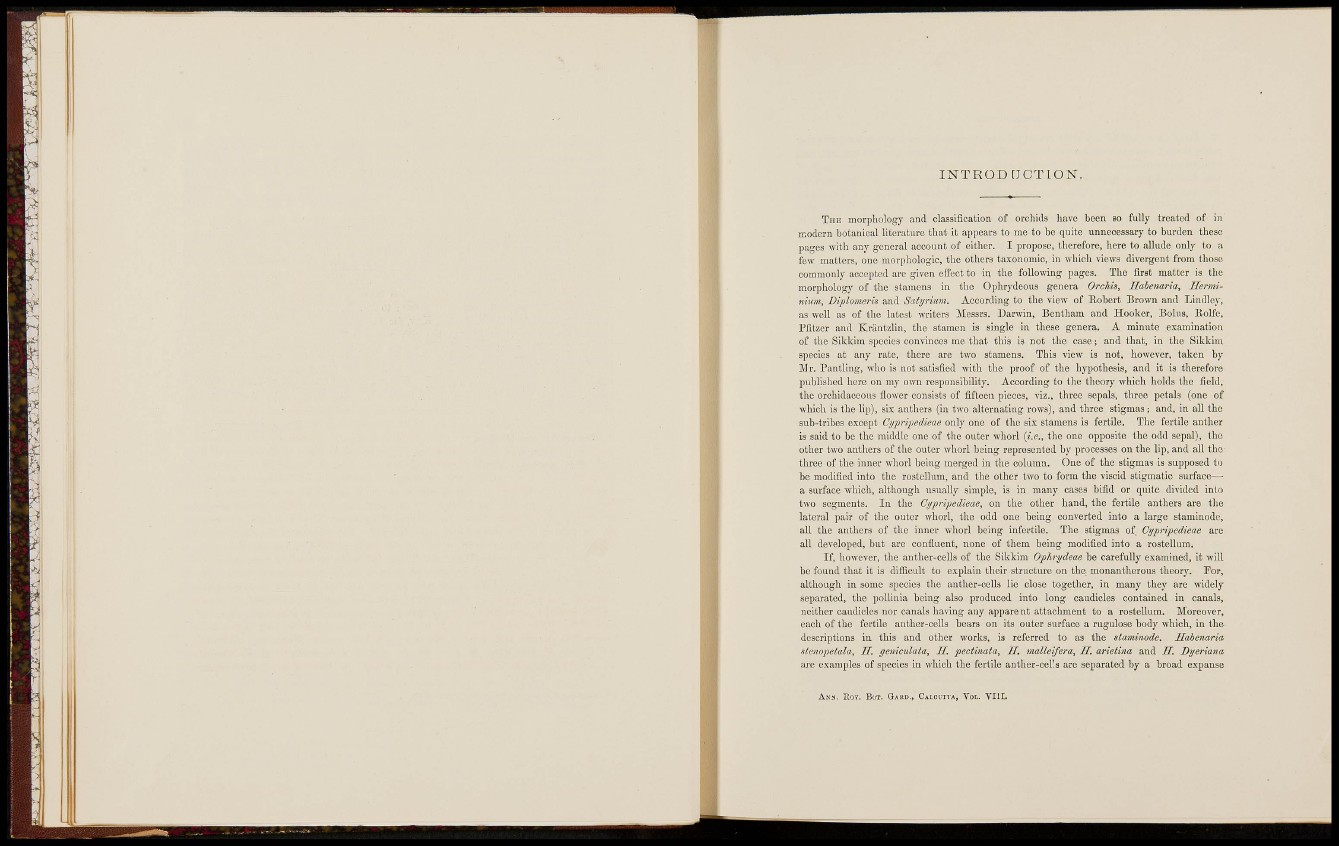
B
yP
I N T R O D t J C T L O N .
THE morphology and classification of orchids have been so fully treated of in
modern botanical literature that it appears to me to be quite unnecessary to burden these
pages with any general account of either. I propose, therefore, here to allude only to a
few matters, one morphologic, the others taxonomic, in which views divergent from those
commoiily accepted arc given effect to in the following pages. The first matter is the
morphology of the stamens in the Ophrydeous genera Orchis, Hahenaria, Herminiim,
Diplomoris and Satyrum. According to the view of Eobert Brown and Lindle)',
as well as of the latest writers Messrs. Darwin, Benlham and Hooker, Bolus, Bolfe,
Pfitzcr and Kriintzlin, the stamen is single in these genera. A minute examination
of the Sikkim species convinces me that this is not the case; and that, in the Sikkim
species at any rate, there are two stamens. This view is not, however, taken by
Mr. Pantling, who is not satisfied with the proof of the hypothesis, and it is therefore
published here on my own responsibility. According to the theory which holds the field,
the orchidaceous fiower consists of fifteen pieces, viz., three sepals, three petals {one of
which is the lip), six anthers (in two alternating rows), and three stigmas ; and, in all the
sub-tribes except Cypripedieae only one of the six stamens is fertile. The fertile anther
is said to be the middle one of the outer whorl [i.e., the one opposite the odd sepal), the
other two anthers of the outer whorl being represented by processes on the lip, and all the
three of the inner whorl being merged in the column. One of the stigmas is supposed to
be modified into the rostellum, and the other two to form the viscid stigmatic surface—
a surface which, although usually simple, is in many cases bifid or quite divided into
two segments. In the Cypripedieae, on the other hand, the fertile anthers are the
lateral pair of the outer whorl, the odd one being converted into a large staminode,
all the anthers of the inner whorl being infertile. The stigmas of Cypripedieae are
all developed, but are confluent, none of them being modified into a rostellum.
If, however, the anther-cells of the Sikkim Ophrydeae be carefully examined, it will
be found that it is difficult to explain their structure on the monantherous theory. Tor,
although in some species the anther-cells lie close together, in many they are widely
separated, the pollinia being also produced into long caudicles contained in canals,
neither caudicles nor canals having any apparent attachment to a rostellum. Moreover,
each of the fertile anther-cells bears on its outer surface a rugulose body which, in the
descriptions in this and other works, is referred to as the staminode. Uabenaria
stcnopetala, H. genictdata, H. poctinata, H. mallei/era, U. arietina and H. Dyeriana
arc examples of species in which the fertile anther-cella arc separated by a broad expanse
As.x. ROT. BOT. GARD., CALCCTTA, VOL. VIII.